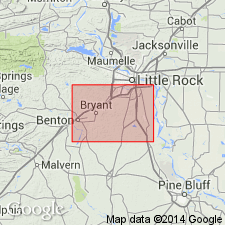
- Usage in publication:
-
- Detonti sand*
- Modifications:
-
- Original reference
- Dominant lithology:
-
- Clay
- Sand
- Lignite
- AAPG geologic province:
-
- Ouachita folded belt
Summary:
Pg. 11 (fig. 4), 55-58, pls. Detonti sand of Wilcox group. Homogeneous sand unit containing some interbedded gray clay lenses and a prominent lignite bed at base. Best known from drillholes; as interpreted from logs thickness ranges from 207 to 412 feet. Unconformably overlies Saline formation (new); covered at many localities by deposits of gravel of late Tertiary age. Age is Eocene.
Type section: on east bank of first prominent gully west of Detonti on Detonti-Tull Road near center of NW/4 NW/4 NW/4 sec. 4, T. 3 S., R. 14 W., Saline Co., [Tull 7.5-min quadrangle], central AR. Named from settlement of Detonti on Missouri Pacific RR. Crops out in irregular northwestward-trending belt up to 3 mi wide and is probably continuous across bauxite region. Cut off at northeast by overlap of sediments higher in section and by Quaternary alluvial sediments of Arkansas River flood plain.
Source: US geologic names lexicon (USGS Bull. 1200, p. 1100).
For more information, please contact Nancy Stamm, Geologic Names Committee Secretary.
Asterisk (*) indicates published by U.S. Geological Survey authors.
"No current usage" (†) implies that a name has been abandoned or has fallen into disuse. Former usage and, if known, replacement name given in parentheses ( ).
Slash (/) indicates name conflicts with nomenclatural guidelines (CSN, 1933; ACSN, 1961, 1970; NACSN, 1983, 2005, 2021). May be explained within brackets ([ ]).

